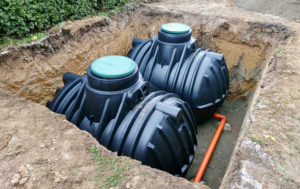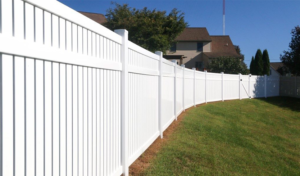You may use an onsite septic system to treat your wastewater when living outside the city. Think of it like a spider — the tank is the body, and the legs are long pipes that go into your drain field.
Poo and pee are dumped into the septic tank, where bacteria break it down. The liquid then floats to the top, flowing into the drain field. Contact Septic Tank Armadale now!

The plumbing in your home’s bathrooms, kitchen, and laundry room feed into a drainage pipe that leads underground to your septic tank. Your septic tank is a buried, water-tight container made of concrete, fiberglass or polyethylene that holds wastewater for an adequate time to allow microorganisms to decompose organic household waste and treat the wastewater before it exits the system. This is done by separating the waste into three distinct layers. Solid materials sink to the bottom of the septic tank forming sludge, oils and greases float to the top forming scum, and a clear layer of liquid wastewater (effluent) remains in the middle.
The bacteria in your septic tank generate gases while breaking down the waste. The most common is hydrogen sulfide, which has a very unpleasant odor. To reduce the smell and protect your family, the septic tank is equipped with a vent that blows off the hydrogen sulfide along with a filter to control odors. The septic tank is also designed with a riser cover that is above ground level, which allows for cleaning, inspection and pumping without digging up your yard.
When the septic tank is full, it will be topped with a lid that is secured to the tank with a gasket and a metal clamp. The lid must be kept sealed with a non-leak seal, especially when it is being used or pumped. A septic tank that is not regularly pumped will begin to build up with sludge, which can eventually cause your septic system to fail.
A septic tank can last 50+ years but the system will need to be inspected, cleaned and pumped periodically. The longevity of your septic system depends on the design, soil conditions, location and proper maintenance. The key to a long life for your septic system is to design it properly in the beginning. Ensure that you have an adequately sized tank, an appropriately sized drain field, and one that has had a percolation test done. In addition, it is important to use a non-leachable toilet paper, install efficient showerheads and faucets, limit the number of people using the system at one time and run your dishwasher, washing machine and ice maker on different days.
How does a septic tank work?
When you flush your toilets, bathtub or sinks wastewater passes through a main drainage pipe that leads to your septic tank. Wastewater is comprised of blackwater, which comes from bathroom and kitchen drains, and greywater, which is the water from washing machines and dishwashers. The septic tank is underground and holds the waste water long enough for solid materials to settle at the bottom and float at the top. This allows the septic system to separate the solid waste from the liquid wastewater (called effluent).
The sludge layer on the bottom of the septic tank contains feces and other organic material that needs to be broken down by microorganisms. The scum layer on the top contains fats, oils and anything less dense than water. The liquid wastewater layer between the sludge and scum layers is where the anaerobic bacteria live. The bacteria feed on the organic wastewater pollutants and break them down, which allows the septic system to function as designed.
Liquid wastewater then flows out of the septic tank into your septic system drain field. This is a large area of perforated pipes that sit on a bed of gravel to allow the sewage to seep through the soil and enter groundwater. A septic tank with an inlet baffle wall prevents sludge and scum from entering the absorption field, which would otherwise clog the piping and reduce the efficiency of the system.
As the liquid effluent passes from your septic tank to the drain field, it is pushed into the soil by hydraulic pressure and by the anaerobic bacteria living in the drain field. This helps the sewage to leach into the soil, where it is absorbed naturally and is eliminated through percolation in the ground, through plant uptake, and by evaporation.
While it may be tempting to plant shrubs or trees in the drain field, it’s important not to do so as it can compact the soil and block wastewater flow. It’s also important not to park a vehicle or truck on the drain field as this can damage the pipe. You should also avoid putting non-organic waste into your septic tank, such as paper towels, napkins, hand wipes, and other items that are not septic safe.
How often do I need to pump my septic tank?
The EPA recommends you have your septic tank pumped every three to five years for a family of four or less. This helps keep the tank from overflowing into your absorption field. An overfull tank causes sewage to back up into your home and can be hazardous to the health of those living in it.
There are many variables that can affect the service intervals for your septic tank, including the size of the tank and the number of people living in your house. You also need to take into consideration your laundry habits, the presence of a garbage disposal, the type of chemicals you use (paint thinner, polyurethane, antifreeze, bleach, some dyes, disinfectants and water softeners) and the climate where you live.
A septic system works best when it is full of healthy bacteria. This is why it is important to only flush toilet paper and human waste down your drains. Other waste like cat litter, trash, tampons and feminine hygiene products should go in the garbage. These items will clog your septic system and cause expensive overflows that can pollute the environment and harm your property.
Another common cause of septic tank failure is the lack of proper maintenance and overuse of your septic system. You should repair leaks, limit the amount of water used in your home, and avoid doing all of your laundry in one day to reduce the load on your septic system.
If you have a septic tank, it is also a good idea to install a septic system alarm that will notify you when the septic tank needs to be pumped. This will help to prevent overflows and save you money on your utility bills.
You can monitor the level of sludge in your septic tank by purchasing a septic tank level indicator or making your own. To make a homemade septic tank level indicator, simply attach an 18-24 inch velcro strip to the end of a stick that’s 7 feet long and then lower it into your septic tank until you feel it hit bottom. The dark, thick sludge will cling to the velcro strip, and you can easily measure the level of sludge in your tank using this handy tool.
What is the cost of a septic tank?
The cost of a septic tank depends on a number of variables including materials, tank size, alternative system types and more. During an estimate, the plumber will consider all of these factors to give you the most accurate and complete quote for your project.
Almost all areas require a permit for the installation of a septic system. This fee usually runs a few hundred dollars.
The septic tank itself is typically priced between $1,500 and $4,500. The most common tanks are made of concrete, although plastic and polyethylene options are available as well. The tank size is typically based on the number of bedrooms in the home instead of bathrooms, as this better represents how much wastewater will be produced daily.
In order to install a septic system, the soil must first be tested. This is usually done by a licensed engineer and costs around $1,000. The septic tank itself is then buried underground, where it will collect and treat the wastewater using bacterial decomposition. The leach field, or drainfield, is then installed, which can also be costly depending on the soil type and depth.
Another factor to consider is the cost of any additional components that may be needed for your specific septic system. These can include a baffle, alarms, pumps and other features. These costs can add up quickly and will often be covered by homeowner’s insurance.
Piping carries waste from your home to the septic tank and then from the tank to the leach field. The amount of piping you need will determine the cost, which can vary from 100 feet of 4-inch perforated PVC for $65 to $180.
A septic tank riser provides access to the septic system from above ground and can reduce your pumping costs by allowing you to get rid of liquid waste more easily. The costs of a riser can run from $100 to $200 depending on the material used.
A septic tank baffle is designed to prevent scum from flowing over the inlet or outlet pipes. A septic tank baffle costs around $200-$600 on average to replace.







